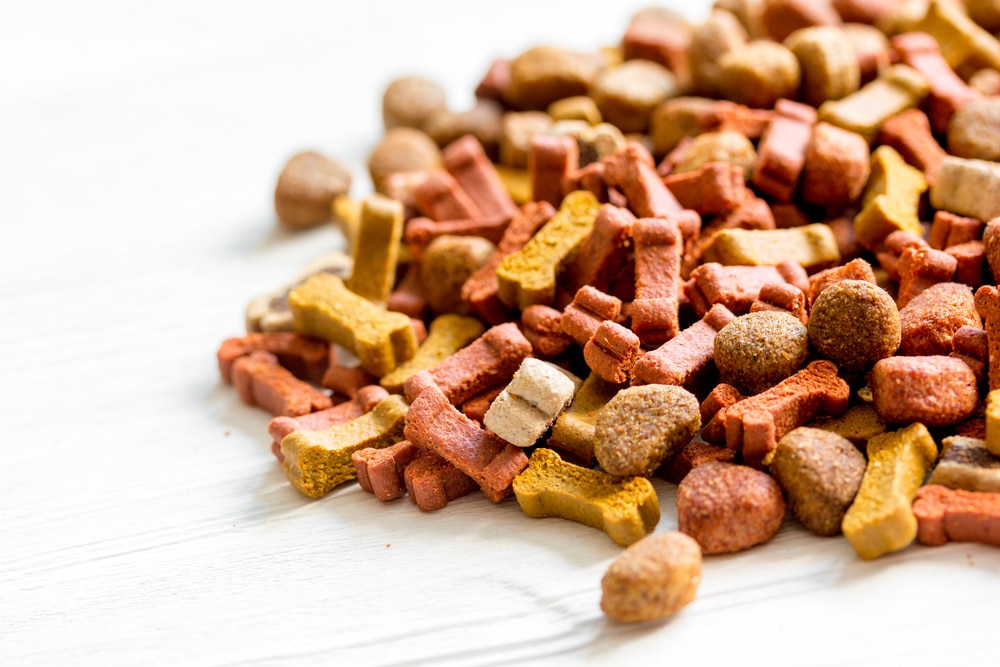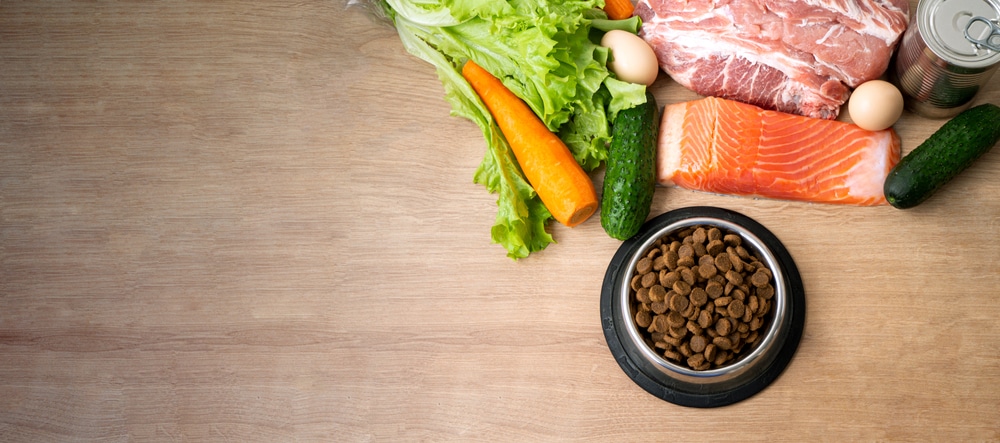We all love to feed our dogs. Sometimes we offer them treats and experiment with different foods to see which one suits our dog best in terms of health. Are you a dog owner looking for the best dog food ingredients that have all the essential nutrients in a balanced way? Then look no further because in this article we’re going to discuss what the best ingredients in dog food are.
The best dog food ingredients are a perfect blend of ingredients that form a balanced canine diet. The following are the best ingredients in dog food: meat (a source of protein), vegetables (a carbs and fiber source), fruits (vitamins), oil like olive oil or fish liver oil (a source of essential fats), minerals, and lastly water.
Table of Contents
What Are The Basics Of Dog Nutrition?

Dogs are monogastric animals (animals with a single-compartment stomach) with a simple stomach equipped with glandular tissue to digest meat. In the wild, a dog’s diet is mainly composed of meat acquired from hunting prey. Meat is a rich source of protein and an important part of a dog’s diet.
Six essential nutrients: carbohydrates, protein, fat, vitamins, minerals, and, most importantly, water meet a dog’s nutritional requirements.
A dog’s body requires these nutrients to grow, function, and maintain physiological balance. For instance, the growth of muscles and bones requires energy, fat, protein, and minerals. Similarly, vitamins like B-12 are involved in red blood cell formation, and vitamin D is required to absorb calcium. Fats in the diet are important in providing energy and absorbing fat-soluble vitamins like A, D, E, and K
Lastly, water is the most important nutrient because water makes up 70 percent of a dog’s body weight. Therefore, an adequate amount of fresh drinking water should always be available for a dog.
Moreover, water is involved in maintaining homeostasis (a biological balance of the body), required by the dog for maintaining body temperature and other body functions.
What Makes A Balanced Dog Diet?
A balanced dog diet is made up of all six basic nutrients in balanced proportion, which should be easily digestible, and should be efficiently utilized to help dogs grow, maintain weight, and perform physical activity.
However, different life stages in dogs have variable nutrient requirements. For instance, a puppy, adult, and senior dog have entirely different energy and protein requirements.
Protein Requirements
Puppies have a 30 to 40% protein requirement whereas adult dogs have a 20 to 25% protein requirement in their diet. Senior dogs have higher protein requirements of more than 30% because of loss of muscle mass, and they require protein for healing.
Energy Requirements
A puppy’s energy requirements are also higher. A 0-4 month-old puppy energy requirement can be calculated by 3*RER. RER is the resting energy requirement, which is defined as minimal energy for maintenance, and is calculated by the given formula:
RER = 70 × (Body weight)3⁄4 gives energy in kcal.
Adult active dogs’ energy requirement: 2 × RER
Overweight and old dogs should be fed a diet low in calories: 1.2 to 1.4 × RER
Fat Requirement
Fats are primarily a source of energy, 1 gram of fat provides 9 kilocalories (kcal) in energy. Puppies require higher dietary fat for growth and therefore 8.5% fat of dry matter content is required by puppies. Dry matter is the dry portion of dog food after subtracting moisture content.
Adult dogs, on the other hand, have lower fat requirements of 5.5%. Senior dogs should also have a low-fat requirement of around 5% because they need a low-calorie and high-protein diet.
Moreover, exceptions are made for dogs with sensitive stomach, liver, and kidney diseases. A low-protein and high-fat diet is suitable for a dog with liver and kidney disease.
Meat: A Source Of Protein
Meat is a rich source of protein in a dog’s diet and is the best ingredient for optimal growth and performance. Things like chicken, beef, lamb, pork, and fish are high in protein. Dogs require protein for growth, healing, and immunity, and because protein also acts as enzymes and hormones.
Meat also provides the 10 essential amino acids that are crucial for a dog’s survival. Amino acids are building blocks of protein and dogs need them for many key body functions.
Amino acids make enzymes that also act as substrates in various metabolic reactions in the body. There are 20 amino acids, of which the body makes 10 and the dog needs to eat the other 10, like arginine, lysine, methionine, and more. Moreover, 18% of the calories in a diet should come from a protein source provided by meat.
Additionally, meat also provides essential fats like linolenic acid. Fish oil provides omega-3 fatty acids important for coat health. Organ meat provides vitamins A, B, D, and E along with copper, zinc, iron, and selenium.
Furthermore, meat in diets fulfills the natural instinct of a dog that would drive it to eat flesh in the wild. Lastly, meat is important to maintain fur health and improve coat strength.
Vegetables: A Source Of Carbs, Vitamins, And Fiber
Second on the list of best food ingredients are vegetables, a rich source of carbs, vitamins, and fiber in the diet. Vegetables like carrots, spinach, and pumpkin are rich in vitamins like vitamins A, C, B1, and minerals like iron, calcium, and magnesium. Corn oil is rich in omega-6, an essential fatty acid. Vitamin A is good for vision, vitamin C is an antioxidant, and vitamin B1 promotes glucose.
Also, vegetables provide a good source of fiber in a diet. Dog foods should have 2-3% fiber, which is essential for promoting gut health. Fiber is fermented in the gut with the action of intestinal enzymes that produce fatty acids (a product of fermentation) and enhance acidity preventing bad bacteria from growing. They also maintain healthy microflora in the gut that aid in digestion. Therefore, fiber is an essential ingredient for a healthy gut.
As an example, 100 grams of pumpkin contains 0.5 grams of fiber content.
Fruits: A Source Of Energy And Vitamins
Fruits are a rich source of energy and vitamins and can add a little treat factor to a dog’s diet. Things like apples without seeds, pears, cucumbers, bananas, and watermelons without seeds make up a tasty and healthy combination of carbs, vitamins, minerals, and water.
Please be careful not to allow any fruit seeds in your dog’s diet. For instance, apple seeds contain amygdalin, a compound that releases cyanide, which is poisonous to dogs.
Avoid fruits like grapes as they can cause raisin toxicity in dogs even in small amounts like a few grams.
Minerals In A Dog’s Diet
There are two classes of minerals: macrominerals and microminerals. Macrominerals include calcium, magnesium, phosphorus, sodium, potassium, and chloride, whereas microminerals are trace minerals including zinc, copper, iron, iodine, and selenium, to name a few.
As we all know, calcium and phosphorus are crucial for bone health and growth, and any deficiency may lead to weak and porous bones and cause bending of bones as seen in rickets in pups.
Microminerals like zinc and selenium help boost immunity, and iron is important for hemoglobin synthesis, a protein in red blood cells that binds oxygen and delivers it to body cells.
Mineral sources include bone meal, organ meat, and green veggies.
The Importance Of Water In A Dog’s Diet
Water itself does not provide any energy, but it is a nutrient that must be present in a diet to maintain homeostasis (biological balance).
A dog also requires water to maintain its body temperature. Water mostly makes up a body’s cells too. Also, the metabolism of fats, proteins, and carbs requires water and also gives off water called metabolic water.
Dogs generally require 30 milliliters (1.01 ounces) of fresh drinking water per kilogram (2.2 pounds) of body weight to function normally.
In Conclusion: What Are The Best Ingredients In Dog Food?
In conclusion, the best ingredients are those food items that, in combination, can balance all the six essential nutrients in dog food and are palatable, easily digested, and non-toxic. The natural food ingredients mentioned above, when used in the correct amounts, keeping in view the specific requirements like age, body weight, and life stage, can make up a healthy diet.
So, what do you think about what dogs need? Did it surprise you in any way? Let us know your thoughts and why in the comments below!
